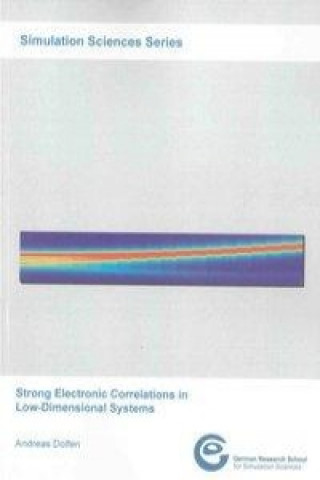
Kód: 12695909
Strong Electronic Correlations in Low-Dimensional Systems
Autor Andreas Dolfen
Understanding strongly correlated systems is one of the most challenging problems of physics. Their properties often sensitively depend on the delicate interplay of kinetic and Coulomb energy rendering them susceptible to external ... celý popis
- Jazyk:
 Angličtina
Angličtina - Vazba: Brožovaná
- Počet stran: 252
Nakladatelství: Shaker Verlag, 2011
- Více informací o knize

Mohlo by se vám také líbit
-

Dune
249 Kč -

Haunting Adeline
621 Kč -

Berserk Deluxe Volume 2
1092 Kč -

White Nights
71 Kč -

Powerless
268 Kč -

Atomic Habits
330 Kč -

Dune Messiah
228 Kč -

Berserk Deluxe Volume 3
1142 Kč -

One Day
221 Kč -

Berserk Deluxe Volume 1
1115 Kč -

Iron Flame
368 Kč -

Surrounded by Idiots
213 Kč -

Harry Potter and the Prisoner of Azkaban (Minalima Edition)
993 Kč -

Gravity Falls Journal 3
441 Kč -

Heaven Official's Blessing: Tian Guan Ci Fu (Novel) Vol. 1
443 Kč -

The Creative Act
568 Kč -

Dune
276 Kč -

Hunting Adeline
624 Kč -

A Little Life
268 Kč -

Children of Dune
230 Kč -

Heaven Official's Blessing: Tian Guan Ci Fu (Novel) Vol. 2
427 Kč
Informovat o naskladnění knihy
Zadejte do formuláře e-mailovou adresu a jakmile knihu naskladníme, zašleme vám o tom zprávu. Pohlídáme vše za vás.
Více informací o knize Strong Electronic Correlations in Low-Dimensional Systems
 Anotace knihy
Anotace knihy
Understanding strongly correlated systems is one of the most challenging problems of physics. Their properties often sensitively depend on the delicate interplay of kinetic and Coulomb energy rendering them susceptible to external perturbations. To understand and predict experimental results we need methods to reliably describe these materials. In this thesis we tackled the problem from two different perspectives: the construction of appropriate models and the evaluation of dynamical lattice response functions. At first we derive realistic material-specific Hubbard model parameters for organic crystals. We extract the simplest parameters, the hopping integrals t, from the bonding/anti-bonding splitting of the relevant orbitals in a tight-binding dimer. The main challenge is the proper evaluation of the screening for the Coulomb integrals, which we tackle with a three-step approach. At first we calculate the Hartree-integrals. To assess the screening of the electrons within the molecules alone we calculate DFT total energies for additional charges in the molecules. The orbital relaxation effect in the self-consistent calculation yields the screening energy. The final step captures the effect of all molecules. With a quantum mechanical treatment being infeasible we resort to a classical electrostatic method which effectively describes a non-polar molecular crystal in terms of a microscopic point-dipole model. We apply this method to two organic crystals: TTF-TCNQ and (BEDT-TTF)_2 I_3. Having the parameters of the former we solve a long standing problem in the interpretation of its spectra. One of the most successful methods to treat strongly correlated systems is DMFT. It provides a good approximation to local correlations and direct access to quantities such as the local self-energy. While lattice spectral functions follow directly from the self-energy, general lattice susceptibilities are difficult to obtain. To make the evaluation feasible we rewrite the susceptibilities as ladder diagrams, where the vertex part is then approximated by the local DMFT vertex. From the vertex and the lattice bubbles we can evaluate arbitrary susceptibilities. We employ Padé approximants to analytically continue our Matsubara results to the real-frequency axis. Since accuracy is of paramount importance, we make up for the finite approximations to the infinite vertices by using a "roaming vertex" scheme which captures the most relevant part of the vertex. Moreover, we perform the computations for different matrix sizes and extrapolate to the infinite limit. As an application we choose a three-dimensional periodic Anderson model.
 Parametry knihy
Parametry knihy
- Plný název: Strong Electronic Correlations in Low-Dimensional Systems
- Autor: Andreas Dolfen
- Jazyk:
 Angličtina
Angličtina - Vazba: Brožovaná
- Počet stran: 252
- EAN: 9783832299156
- ISBN: 3832299157
- ID: 12695909
- Nakladatelství: Shaker Verlag
- Hmotnost: 564 g
- Rozměry: 238 × 169 × 22 mm
- Datum vydání: May 2011
Osobní odběr Praha, Brno a 12903 dalších
Copyright ©2008-24 nejlevnejsi-knihy.cz Všechna práva vyhrazenaSoukromíCookies



 Vrácení do měsíce
Vrácení do měsíce 571 999 099 (8-15.30h)
571 999 099 (8-15.30h)